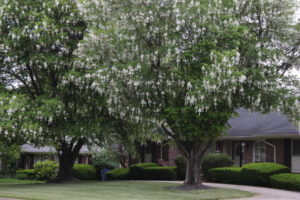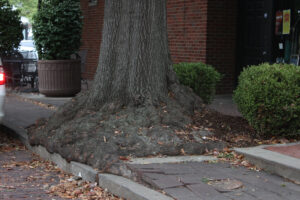Trees – they enhance our urban lives in so many ways. They allow us to live with nature providing food and shelter for insects and birds. Their roots absorb and channel vast amounts of rain water that cannot penetrate the ground when it falls on roofs, patios, driveways, streets, sidewalks and parking lots. In doing so, they also process many of the pollutants that cities generate and they help to keep streams and rivers healthy.

What I cherish most about trees is their shade. Walking along a tree-lined street on a hot sunny day, or getting into a car that is parked under dense foliage, or sitting in an outdoor café where shade comes from a leafy canopy – these are comforts to help me cope with our merciless summer heat.
Such comforts are not abundantly available in Lexington. True, there are some tree-lined streets in the city with relatively safe sidewalks, and occasionally I do find that parking space under a tree for which I am always on the look-out. When it comes to enjoying a meal or a glass of wine under the canopy of tall trees – well, all of us who have done just that at Michler’s Native Café know how rare it is in Lexington and how much we yearn for more public spaces like this.

We have ample rainfall in the Bluegrass and our fertile soils support a rich variety of trees. Why does it seem so difficult to harness these resources for creating a more richly treed city? Three reasons seem to stand out. There are the wires running both above and below ground and the underground pipes needed to service urban homes and businesses. They limit where trees can be grown.
Two other reasons for our relative dearth of trees are less compelling. One has to do with advertising: businesses along major roads want their signs to be visible, which results not only in treeless, but also in very ugly urban spaces, since each sign aims to outcompete its neighboring sign. Trees could provide relief from this visual assault, but if they are allowed at all, they must be small or spindly – essentially invisible. In an era when advertising is rapidly moving to the internet, this kind of urban landscape should become obsolete, but Lexington is still embracing big-billboard promotions.
Private properties are, in principle, more amenable to trees. In the past, before air-conditioning, homes were designed and spaced to make room for shade trees to provide cooling. Home-owners cherished those trees and invested money and work into maintaining them. But that seems like a habit of the distant past now. How often have I heard of the nuisance that trees cause, because their leaves must be raked, twigs that drop from them must be picked up, their fruit is messy, they heave up sidewalks, they appear to endanger a structure (a belief rarely confirmed by asking an expert). Trees seem unnecessary to human lives glued to a cellphones or TV screens.
Tree Week, now in its fourth year, attempts to change that attitude, to teach us all to love trees again, to embrace the benefits they provide to urban spaces and to find meaning in the occasional work they require.
Beate Popkin
